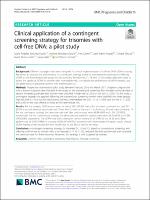| dc.contributor | Vall d'Hebron Barcelona Hospital Campus |
| dc.contributor.author | Sánchez Durán, Maria Ángeles |
| dc.contributor.author | Bernabeu García, Andrea |
| dc.contributor.author | Calero Fernández, Inés Zulema |
| dc.contributor.author | Ramis Fossas, Jordi |
| dc.contributor.author | Illescas Molina, Tamara |
| dc.contributor.author | Avilés García, Maite |
| dc.contributor.author | Maiz Elizaran, Nerea |
| dc.contributor.author | Carreras Moratonas, Elena |
| dc.date.accessioned | 2020-02-24T10:50:27Z |
| dc.date.available | 2020-02-24T10:50:27Z |
| dc.date.issued | 2019-08-01 |
| dc.identifier.citation | Sánchez-Durán MÁ, Bernabeu García A, Calero I, Ramis Fossas J, Illescas T, Avilés MT, et al. Clinical application of a contingent screening strategy for trisomies with cell-free DNA: a pilot study. BMC Pregnancy Childbirth. 2019;19(1):274. |
| dc.identifier.issn | 1471-2393 |
| dc.identifier.uri | https://hdl.handle.net/11351/4670 |
| dc.description | Cell-free DNA; Contingent screening; Fetal trisomy |
| dc.description.abstract | BACKGROUND:
Different strategies have been designed for clinical implementation of cell-free DNA (cfDNA) testing. We aimed to evaluate the performance of a contingent strategy based on conventional screening and offering cfDNA to the intermediate-risk group, for the screening for trisomies 21, 18 and 13. Secondary objectives were to assess the uptake of cfDNA in women with intermediate-risk, to evaluate the performance of cfDNA testing, and the preferences of pregnant women with intermediate risk.
METHODS:
Prospective observational pilot study between February 2016 and March 2017. Singleton pregnancies with a known outcome were included in the study. At the conventional screening (first trimester combined test or second trimester quadruple test) women were classified in high (risk ≥1:250) or low risk (< 1:250). For the study, a contingent strategy was applied: following the conventional screening women were classified into three groups: high risk (risk ≥1:10 or nuchal translucency ≥3 mm), intermediate-risk (risk 1:11 to 1:1500) and low risk (< 1:1500), and a cfDNA test was offered to those at the intermediate risk.
RESULTS:
For the analysis, 2639 women were included, 2422 (91.8%) had a first trimester combined test and 217 (8.2%) a second trimester quadruple test. There were 5 cases of trisomy 21, 4 of trisomy 18 and none of trisomy 13. For the contingent strategy, the detection rate and false positive rates were 88.9% (8/9) and 1.3% (35/2630), respectively. For the conventional strategy, the detection rate and false positive rates were 66.7% (6/9) and 5.3% (140/2630), respectively. The cfDNA test had a detection rate for trisomy 21 of 100% (3 out of 3), and a false positive rate of 0.2% (1/466). In a survey, 81.8% (374/457) of women in the intermediate-risk group would choose cfDNA testing as the second line test, mainly due to the lack of risk for the fetus.
CONCLUSION:
A contingent screening strategy for trisomies 21, 18 and 13, based on conventional screening, and offering a cfDNA test to women with a risk between 1:11 to 1:1500, reduced the false positive rate and increased the detection rate for these trisomies. Moreover, this strategy is well accepted by women. |
| dc.language.iso | eng |
| dc.publisher | Springer |
| dc.relation.ispartofseries | BMC Pregnancy and Childbirth;19(1) |
| dc.rights | Attribution 4.0 International |
| dc.rights.uri | http://creativecommons.org/licenses/by/4.0/ |
| dc.source | Scientia |
| dc.subject | Àcids nucleics - Anàlisi |
| dc.subject | Sang - Examen |
| dc.subject | Cromosomes humans - Anomalies |
| dc.subject.mesh | Cell-Free Nucleic Acids |
| dc.subject.mesh | Maternal Serum Screening Tests |
| dc.subject.mesh | Trisomy |
| dc.title | Clinical application of a contingent screening strategy for trisomies with cell-free DNA: a pilot study |
| dc.type | info:eu-repo/semantics/article |
| dc.identifier.doi | 10.1186/s12884-019-2434-0 |
| dc.subject.decs | ácidos nucleicos libres de células |
| dc.subject.decs | pruebas maternas séricas de cribado |
| dc.subject.decs | trisomía |
| dc.relation.publishversion | https://bmcpregnancychildbirth.biomedcentral.com/articles/10.1186/s12884-019-2434-0 |
| dc.type.version | info:eu-repo/semantics/publishedVersion |
| dc.audience | Professionals |
| dc.contributor.authoraffiliation | [Sánchez-Durán MA, Bernabeu García A, Calero I, Illescas T, Avilés MT, Maiz N, Carreras E] Servei de Medicina Maternal i Fetal, Hospital Universitari Vall d’Hebron, Barcelona, Spain. Universitat Autònoma de Barcelona, Barcelona, Spain. [Ramis Fossas J] Universitat Autònoma de Barcelona, Barcelona, Spain. Servei de Laboratori, Hospital Universitari Vall d'Hebron, Barcelona, Spain |
| dc.identifier.pmid | 31370808 |
| dc.identifier.wos | 000478668300003 |
| dc.rights.accessrights | info:eu-repo/semantics/openAccess |


